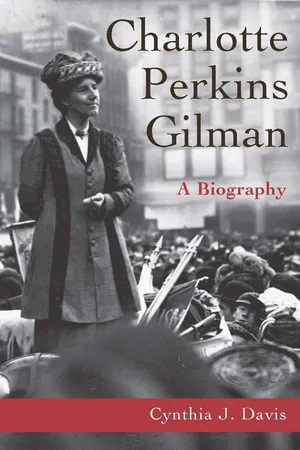
- 568 pages
- English
- ePUB (mobile friendly)
- Available on iOS & Android
About this book
Charlotte Perkins Gilman offers the definitive account of this controversial writer and activist's long and eventful life. Charlotte Anna Perkins Stetson Gilman (1860–1935) launched her career as a lecturer, author, and reformer with the story for which she is best-known today, "The Yellow Wallpaper." She was hailed as the "brains" of the US women's movement, whose focus she sought to broaden from suffrage to economics. Her most influential sociological work criticized the competitive individualism of capitalists and Social Darwinists, and touted altruistic service as the prerequisite to both social progress and human evolution.
By 1900, Gilman had become an international celebrity, but had already faced a scandal over her divorce and "abandonment" of her child. As the years passed, her audience shrunk and grew more hostile, and she increasingly positioned herself in opposition to the society that in an earlier, more idealistic period she had seen as the better part of the self. In her final years, she unflinchingly faced breast cancer, her second husband's sudden death, and finally, her own carefully planned suicide— she "preferred chloroform to cancer" and cared little for a single life when its usefulness was over.
Charlotte Perkins Gilman presents new insights into the life of a remarkable woman whose public solutions often belied her private anxieties. It aims to recapture the drama and complexity of Gilman's life while presenting a comprehensive scholarly portrait.
Frequently asked questions
- Essential is ideal for learners and professionals who enjoy exploring a wide range of subjects. Access the Essential Library with 800,000+ trusted titles and best-sellers across business, personal growth, and the humanities. Includes unlimited reading time and Standard Read Aloud voice.
- Complete: Perfect for advanced learners and researchers needing full, unrestricted access. Unlock 1.4M+ books across hundreds of subjects, including academic and specialized titles. The Complete Plan also includes advanced features like Premium Read Aloud and Research Assistant.
Please note we cannot support devices running on iOS 13 and Android 7 or earlier. Learn more about using the app.
Information
Notes
INTRODUCTION
CHAPTER ONE
Table of contents
- Title Page
- Copyright Page
- Dedication
- Table of Contents
- Introduction - The Living of Charlotte Perkins Gilman
- Acknowledgments
- New England
- California
- At Large
- New York
- Norwich
- Pasadena
- Postmortem
- Abbreviations
- Notes
- Select Bibliography
- Index